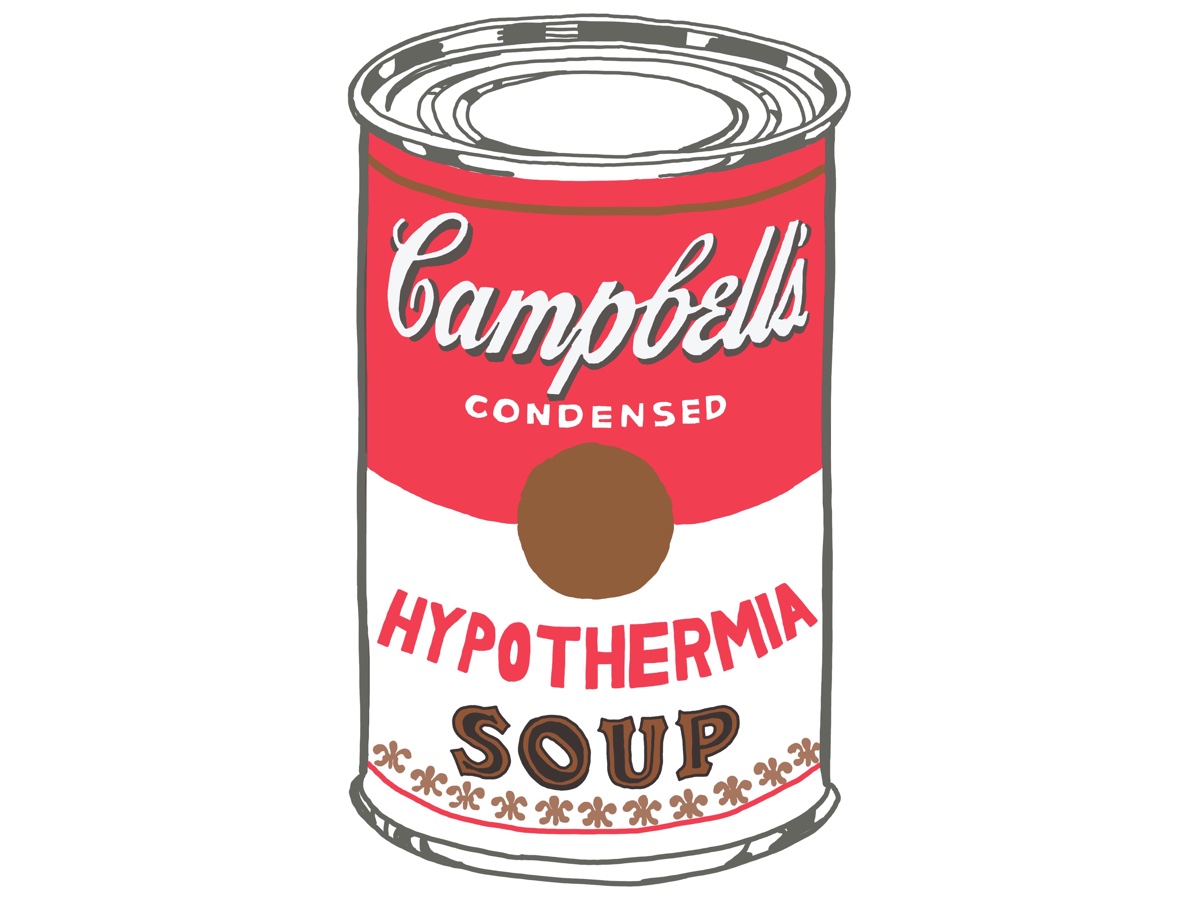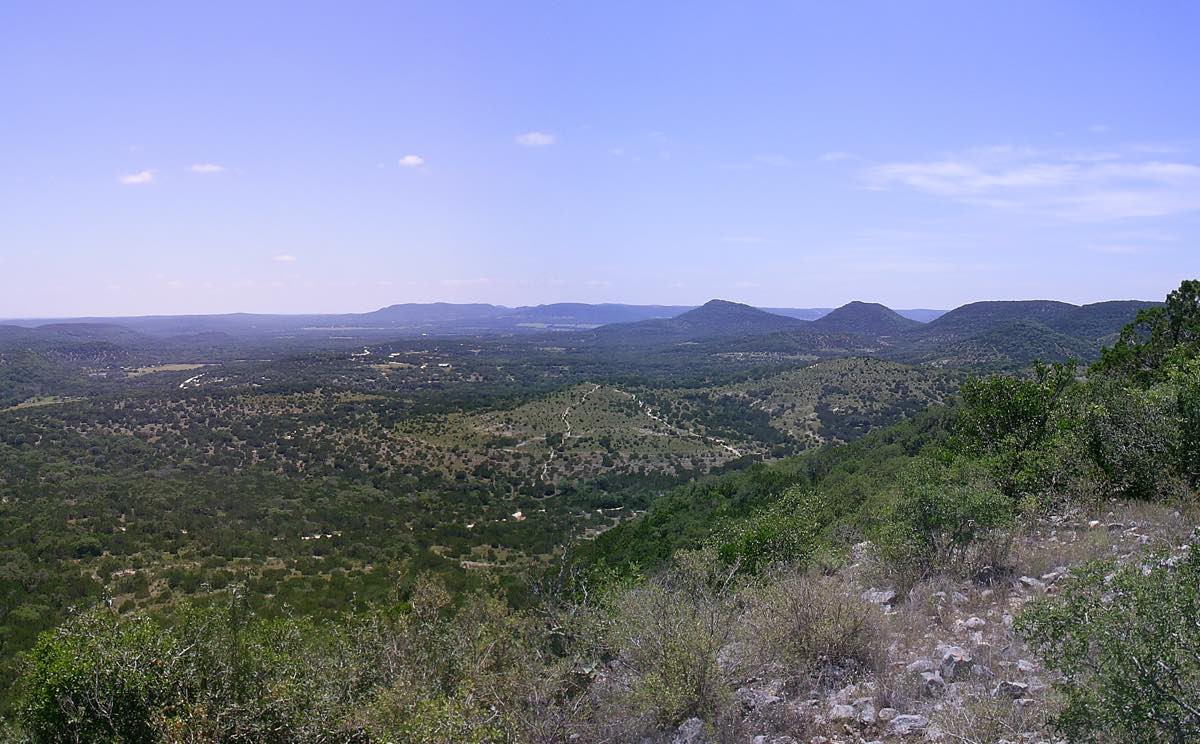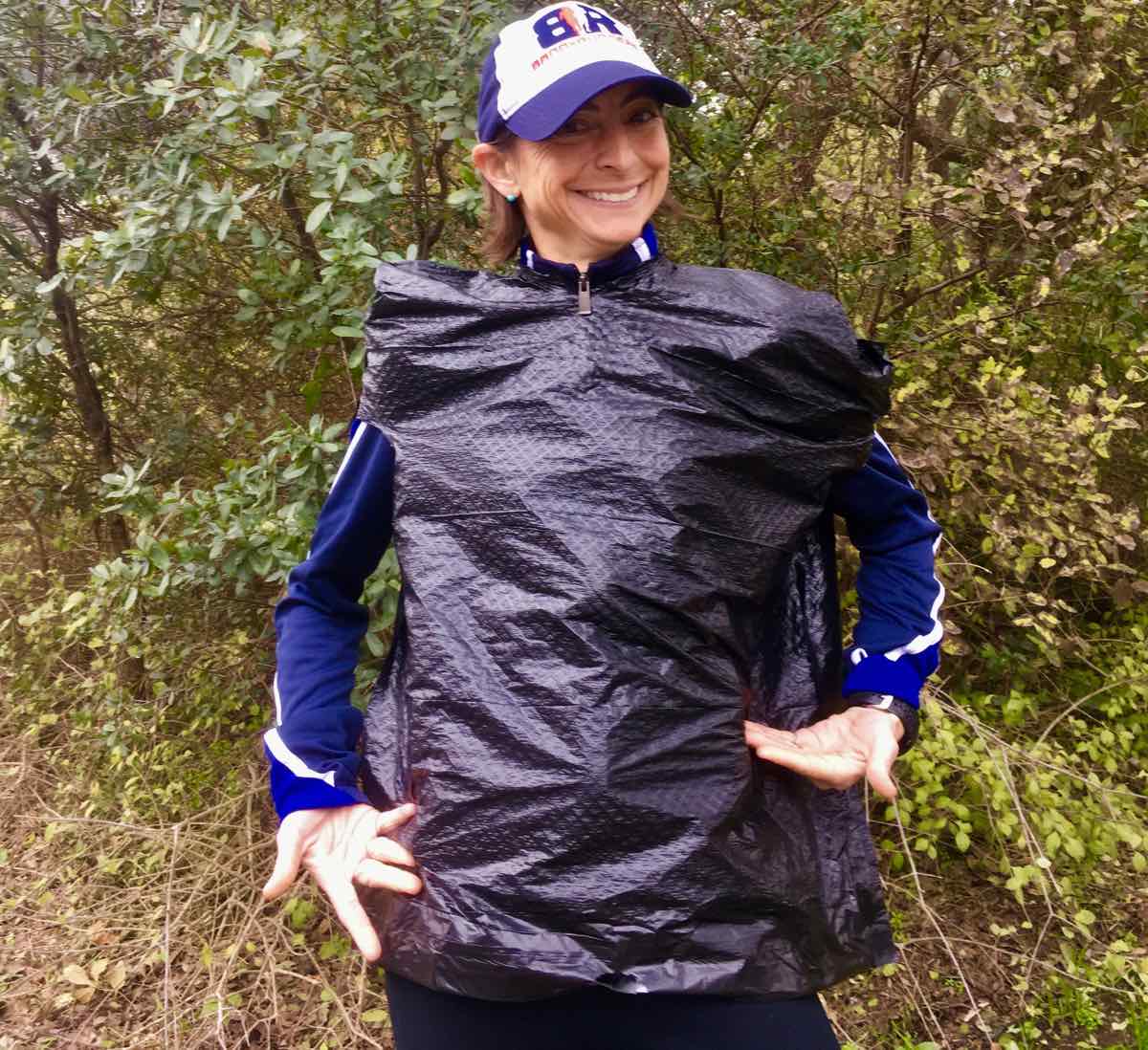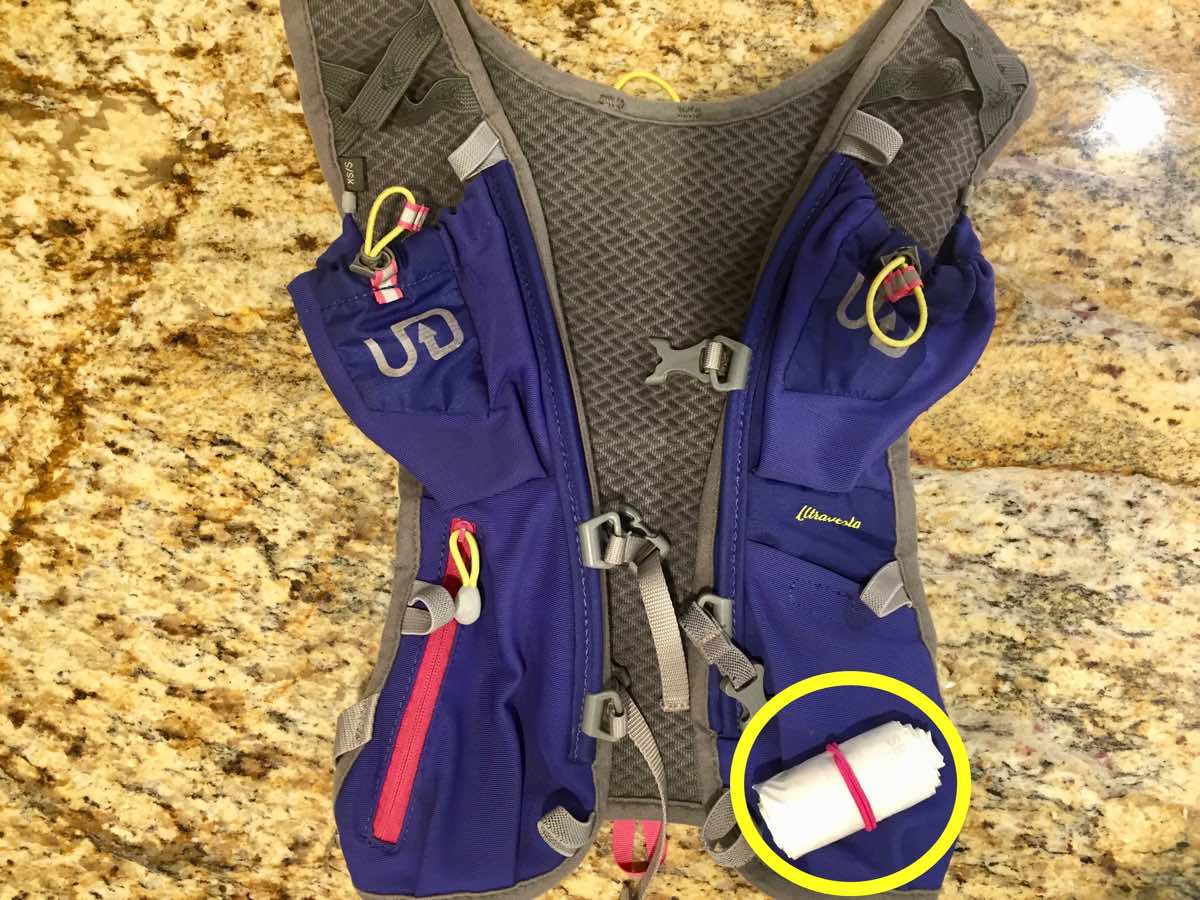Scenario:
You’re running the Bandera 100k down in south Texas. It’s a gorgeous January day with blue skies and temperatures in the upper 50s Fahrenheit.
Truth be told, you’d prefer if it was a bit cooler. Your t-shirt and sports bra are damp with sweat by the time you finish the first 50k loop. You grab a headlamp and a windbreaker and head out into the night, hopeful for a PR.
Unfortunately, in another two miles, your stomach turns and you vomit. Then you vomit again. You’re reduced to hiking. The wind blows harder and the temperature drops. “Dang! It’s cold!” You wish you’d picked up your long-sleeved shirt as well as your hat and gloves. It’s another three miles to the next aid station.
What’s the best thing you can do right now to prevent getting colder?
A. Get out of your wet shirt and put on your windbreaker.
B. Hike faster.
C. Eat a gel.
Try to answer before continuing.
Answers:
A. Get out of your wet shirt and put on your windbreaker jacket.
This is probably the best answer. Wet clothes are going to make it hard to stay warm even if you can pick up your hiking pace. Take off your shirt and put on your dry windbreaker. Put your damp shirt back on over the top of the windbreaker. Wring it out first if it’s actually wet. A wet sports bra will keep you cold. This is true even if you’re putting on multiple dry layers over it. So take it off and put it over a dry layer. (And yes, there’s absolutely nothing worse than trying to change quickly out of a wet sports bra and then put it back on when you’re outside in the cold. But do it anyway.)
B. Hike faster.
Well, sure. The faster you move, the more heat you’ll generate, and the warmer you’ll feel. If you weren’t nauseated and calorie-depleted, this would be the easiest thing to do. Hike fast, pump your arms back and forth, and throw in some arm circles to force warm blood down to your cold fingers.
Unfortunately, you feel too wrecked to do much more than plod.
C. Eat a gel.
Yes, do that! You need calories to move vigorously. And you need to move vigorously to warm yourself. Even if you’re nauseated, a tiny nip off of a gel every couple minutes could help. But get your wet clothes off your skin first.
So in short, doing all of the above would help to ward off a case of creeping hypothermia.
The scenario continues: You don’t do any of these things. You put your head down and continue at a wheels-came-off pace. By the time you get to the Equestrian Aid Station at mile 36, your hands are so cold you have trouble pulling your soft flasks out of your pack. A volunteer pulls them out for you and fills them. You fumble trying to put them back in and drop them twice. You swear. Your teeth are chattering.
“What can I get you now?” the volunteer asks.
What is something you could ask for that would make you significantly warmer?
Take a moment to come up with an answer.
Did you answer, “soup?” Nope. Soup’s not the answer. Hot soup will make you happy, but it won’t raise your body temperature. And if it’s broth, it won’t even supply you with the calories you need to fuel the movement that will warm you. Hot chocolate is better because it has calories, but warm liquid in your stomach still won’t rewarm you.
Did you ask for a trash bag? Because if you did, you win! Make holes for your head and arms, and then enjoy the heat-trapping and wind-blocking magic of plastic.
Make yourself an emergency trash bag to carry with you on all your runs. It’s small and doesn’t weigh anything. The emergency blanket that some races require works best if you’re staying still, but it’s hard to secure around you when you’re moving. If you want to use it on the move, wrap it around you and then put another shirt or jacket on top to help hold it in place–better than nothing when you’re cold!
An emergency trash bag might save your race, and it’ll definitely save you from becoming mildly hypothermic if you get caught out unprepared like the runner in this scenario.
Mild hypothermia is the impaired ability to perform complex tasks, fine-motor shivering, apathy, slurred speech, stumbling, and the ‘umbles:’
Fumble
Grumble
Mumble
Stumble
Tumble
The scenario ends: You don’t ask for a trash bag. You take a cup of soup and hike away from the aid station. You make it a quarter mile down the trail and stumble. The soup goes flying and you tumble onto the trail. Your hands and knees are scraped up. “This is idiotic! I don’t need this!” you grumble apathetically. You head back to the aid station and get a ride back to the start/finish where volunteers wrap you in blankets and put you under a heat lamp. One veteran volunteer tells you she always carries an emergency layer just in case she has to slow down unexpectedly or stop moving. You mumble your thanks for this advice. It takes few hours for you to feel warm and like yourself again. When you do, you immediately regret your DNF.

Image: Semi-Rad/Brendan Leonard
Scenario 2:
You’re a volunteer at the Nachos Aid Station. It’s 1 a.m. and you’ve just finished making some quesadillas when a lone runner walks in.
“Hi there! Do you want some hot chocolate?”
The runner stares at you blankly and heads over to one of the chairs. You ladle up a hot chocolate and take it to him, but he’s shivering uncontrollably and can’t hold the cup himself.
What should you do?
A. Help him drink the hot chocolate.
B. Rub his arms and legs.
C. Give him a shot of bourbon.
D. Wrap him in a blanket and put a hat on his head.
Answers:
A. Help him drink the hot chocolate.
Yes, but not right away. Uncontrollable shivering is moderate hypothermia and you need to something quickly that’ll help him hold onto the heat his shivers are generating.
Moderate hypothermia is uncontrollable violent shivering, worsening of the ‘umbles,’ and altered mental status.
The body is doing its best to generate heat and keep its temperature up. What you need to do is trap the heat and then help fuel it.
B. Rub his arms and legs.
This won’t do anything to warm the runner. It might make you warmer though.
C. Give him a shot of bourbon.
Nope. Don’t share your bourbon. The sensation of warmth you feel after a shot of alcohol is caused by the dilation of blood vessels close to the surface of the skin. The flushed feeling dissipates quickly as the heat from the warm blood is convected away from your body.
D. Wrap him in a blanket and put a hat on his head.
Yes! You need to insulate the patient and trap the heat that he’s generating by shivering. Make sure the runner’s clothes are dry, and then wrap a blanket around him. Next, take a plastic tarp and wrap that around the blanket. The plastic will trap even more heat and prevent the wind from convecting heat away.
Make sure the runner’s head is covered. Despite what your mom told you, you don’t lose most of your heat through your head compared to the rest of your body. But you will lose heat through your head if it’s uncovered. So put a hat on this runner’s head.
As soon as the runner can, have them eat and drink. They need calories to keep up the heat-generating shivering. And then, to make the runner really appreciate you, heat up some water and put it in a water bottle. The runner can hold it in their cold hands or put it anywhere that makes them happy. Make sure it’s not too hot and wrap the bottle in something before handing it to the runner. Numb hands and cold skin aren’t good at detecting ‘too hot.’
You do all these things, and after an hour at the aid station, the runner is still cold, but feeling much better. He’s missed the cutoff though. You tell him about the magic of the trash bag while you wait for a truck to take him to the heat lamps at the start/finish.
If you hadn’t taken these steps, and the runner had continued to lose heat, they could have died. Imagine a scenario where the runner was lost overnight in freezing weather. The colder he got, the more incapable he’d be of rewarming himself. His level of consciousness would decrease, his breathing would slow, and his heart would beat more and more slowly as his core temperature dropped. Ultimately, the lack of oxygen to his vital organs would lead to death.
Scenario 3:
It’s 7 a.m., and you and your family are working the Chapas Aid Station at mile 47. You didn’t expect it to feel so cold, and everyone is pretty miserable. You suggest the kids run around to warm up. “Try jumping jacks,” you tell your spouse. They all glare at you. It seems unlikely you’ll be able to convince them to volunteer with you again unless you can think of a fun and quick way to warm everybody up.
Think of a fun way to get everybody warmed up quickly.
Did you think of this?
Well, now you won’t be able to stop thinking about it. It works well and works in plenty of situations besides just volunteers at an aid station, such as in the middle of the night or in a storm along a trail when you’re getting just a little too cold, and you can get people to do it especially if you introduce it before they are cold. “Here’s what we’ll do if we get cold…”
[Author’s Note: Learn more about caring for hypothermia in the field and other wilderness first-aid skills with a two-day NOLS course. Thank you to Tod Schimelpfenig, NOLS Wilderness Medicine’s Curriculum Director and author of NOLS Wilderness Medicine, for his guidance and oversight of this series. Thanks also to graphic artist Brendan Leonard, the trail and ultrarunner of Semi-Rad fame, for his graphics collaboration in this article series.]
Call for Comments (from Meghan)
- Have you ever had a brush with hypothermia during a trail race or run? What happened and how’d you resolve the issue?
- What do you carry in your pack to help prevent a dangerous situation in cold or wet weather?



